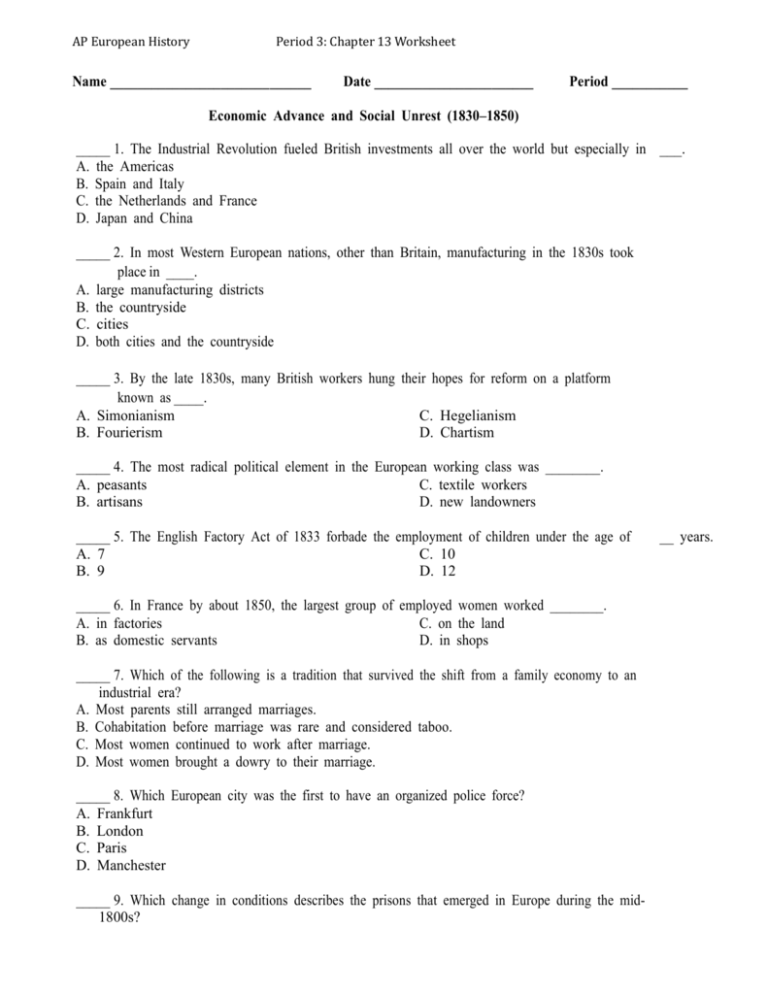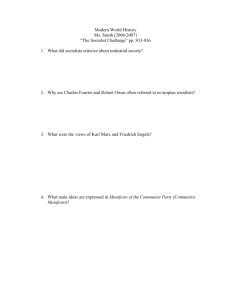Worksheet
advertisement

AP European History Period 3: Chapter 13 Worksheet Name _____________________________ Date _______________________ Period ___________ Economic Advance and Social Unrest (1830–1850) _____ 1. The Industrial Revolution fueled British investments all over the world but especially in ___. A. the Americas B. Spain and Italy C. the Netherlands and France D. Japan and China _____ 2. In most Western European nations, other than Britain, manufacturing in the 1830s took place in ____. A. large manufacturing districts B. the countryside C. cities D. both cities and the countryside _____ 3. By the late 1830s, many British workers hung their hopes for reform on a platform known as ____. A. Simonianism C. Hegelianism B. Fourierism D. Chartism _____ 4. The most radical political element in the European working class was ________. A. peasants C. textile workers D. new landowners B. artisans _____ 5. The English Factory Act of 1833 forbade the employment of children under the age of A. 7 C. 10 B. 9 D. 12 _____ 6. In France by about 1850, the largest group of employed women worked ________. A. in factories C. on the land D. in shops B. as domestic servants _____ 7. Which of the following is a tradition that survived the shift from a family economy to an industrial era? A. Most parents still arranged marriages. B. Cohabitation before marriage was rare and considered taboo. C. Most women continued to work after marriage. D. Most women brought a dowry to their marriage. _____ 8. Which European city was the first to have an organized police force? A. Frankfurt B. London C. Paris D. Manchester _____ 9. Which change in conditions describes the prisons that emerged in Europe during the mid1800s? __ years. AP European History A. B. C. D. Period 3: Chapter 13 Worksheet an individual cell for each prisoner individual cells and long periods of separation and silence among prisoners work skills training an increase in corporal punishment _____ 10. Who was Elizabeth Fry? A. a reformer who exposed the horrible conditions in prisons in England B. a reformer who called for an end to capital punishment C. a reformer who advocated for a police force in England D. a criminal sent to a colony in Australia _____ 11. In the 1840s, the goal of prisons shifted from _____ to _____. A. punishment; rehabilitation B. rehabilitation; punishment C. social segregation; punishment D. social segregation; social integration _____ 12. What classical economist is associated with utilitarianism? A. Thomas Malthus B. Louis Blanc C. Adam Smith D. Jeremy Bentham _____ 13. Who was Karl Marx’s collaborator in the writing of The Communist Manifesto? A. Louis Blanc C. Thomas Malthus B. David Ricardo D. Friedrich Engels _____ 14. Charles Fourier believed that workers were more productive when they ________. A. received frequent praise B. received high wages C. performed the same tasks every day D. worked on different tasks _____ 15. Robert Owen advocated for ________. A. more humane industrial environments B. a large utopian community in England C. worker-owned factories D. the dissolution of the class structure ______ 16. The most radical group of female revolutionary women in France in the 1840s called A. B. C. D. themselves the ________. Scythians Amazons Vesuvians Insurgents AP European History Period 3: Chapter 13 Worksheet _____ 17. During the Magyar revolt in Hungary, the Hungarians tried to annex ________. A. Pressburg C. Bavaria B. Transylvania D. Saxony _____ 18. The migration from the countryside during the nineteenth century produced a situation in which ________. A. the physical resources of cities were stretched beyond capacity B. the physical resources of cities were able to be ratcheted up to meet capacity C. crime rates were unaffected D. diseases were kept at bay _____ 19. Improvements in the railway system meant that ________. A. consumer goods garnered a higher share of investment dollars over capital goods B. ships made of iron were no longer needed C. the working class had a higher purchasing power D. there was a shortage of consumer goods at affordable prices ______ 20. The French Revolution and the wars of Napoleon influenced the development of the A. B. C. D. Industrial Revolution by ________. destroying the French Atlantic trade and disrupting continental economic life inspiring the working class to attain the material wealth and comforts of the middle class increasing trade and demand for goods between Britain and other countries setting back the French economy and French industrialization _____21. Liberal reformers hoped that legal revolutions in land ownership would result in ____ A. a more equitable distribution of agricultural goods B. peasants becoming more industrious and progressive farmers C. a socialistic state D. increased tax revenues for the state _____ 22. In the new labor marketplace, workers ________. A. were brought into the salary system B. had no direct say about product quality C. had no say about product quality D. had considerable bargaining power _____ 23. Proletarianization was closely linked to _______ and ______. A. industrialization; urbanization B. enclosures; the rural economy C. poverty; serfdom D. the elite lifestyle; landowning _____ 24. In the 1830s, workers became concerned about child laborers because ________. A. of the dangerous conditions in the family economy B. of increased competition for factory jobs C. children were willing to work for lower wages than adults D. parents no longer exercised authority over their own children in factorie AP European History Period 3: Chapter 13 Worksheet _____ 25. The shift from the family working together as a unit of production to family members working separately or individually ________. A. led to the destruction of familial bonds B. began the shift to the family as a unit of consumption C. caused the family to become a male-dominated D. helped to decrease gender-based inequities in the workplace _____ 26. Many factories hired unmarried women and children because ________. A. they were less expensive to insure than men or married women. B. they were less likely than men to try to form unions or other work organizations C. there were more unmarried women and children in the labor pool than other workers D. they were willing to work for less than men _____ 27.The decade of the 1820s saw an increase in women working in textile factories. Their new jobs required ________. A. fewer skills than those required in home-based textile work B. more skills than those required in home-based textile work C. more skills than those required by work typically done by men D. at least a grammar school education _____ 28. During the nineteenth century, the domestic division of labor into specific gender patterns prevailed among the ________. A. working, middle, and upper classes B. middle class C. gentry D. rural poor _____ 29. The industrial economy led to the development of gender-determined roles because it________. A. allowed women to work outside the home B. allowed women to develop new skills C. promoted the development of new skills for both males and females D. allowed many families to live on the wages of the male spouse _____ 30. In the late eighteenth century, Britain began transporting criminals to Australia as an alternative to ________. A. capital punishment B. life imprisonment C. public works imprisonment D. transporting them to France _____ 31. Classical economists advocated growth through ________. A. expanded social programs B. government control of enterprise C. free enterprise D. high taxes AP European History Period 3: Chapter 13 Worksheet _____ 32. The goal of the German Zollverein was to create ________. A. better conditions for commerce B. a good climate for industrialization C. a nation-state D. an alliance with Austria _____ 33. The repeal of the Corn Laws in 1846 was an example of the implementation of ______. A. Chartism C. nationalism B. classical economic theory D. socialism _____ 34. A group of writers who helped to define the social question were called ______ by their critics. A. communal economists C. radical socialists B. utopian socialists D. rational economists _____35. What was the name given to the group of activists who rejected industry & government? A. anarchists C. utopian socialists B. early socialists D. Marxists _____ 36. German conservatives gained power by playing on conflicts between ________. A. conservatives and liberals C. conservatives and the working class B. nationalists and liberals D. liberals and the working class _____ 37. The revolutions of 1848 and 1849 ________. A. resulted in a unified middle and working class B. were successful in establishing liberal or national states C. ended monarchy in Europe forever D. failed to establish liberal or national states ______38. A profound split between the German working class and German liberals was marked by_. A. B. C. D. the creation of the Frankfurt Parliament the revolution in Prussia the suppression of a radical revolt in Frankfurt by the German Confederation disagreements over the issue of unification _____39. Nationalism was a particularly strong factor in the revolutions of 1848 among the _____ people. A. French B. British C. Russian D. German _____ 40. Which of the following events helped the political liberals in France gain the support of the working class? A. Minister Guizot’s resignation B. Louis Philippe’s abdication C. the poor harvests of 1846 and 1847 D. the government’s ban on banquets AP European History Period 3: Chapter 13 Worksheet _____ 41. Chartism focused on reforms concerning _________. A. free trade B. suffrage C. trade unions D. social welfare E. votes for women _____42. Which of the following statements about gender roles during the early Industrial Revolution is true? A. Married males were associated with supporting the family. B. Married females were expected to contribute wages to the family economy. C. Unmarried females were rarely factory workers. D. Family discipline shifted away from mothers. _____ 43. What do hulks and the Auburn system have in common? A. both were outgrowths of socialism B. both were utopian socialist movements C. both were penal methods D. both were features of utopian socialism _____ 44. Henri de Saint-Simon was typical of the utopian socialists in __________. A. engaging in both social and economic experimentation B. advocating open marriages C. tying change to industrialization D. attempting change in the rural economy _____45. Which of the following best explains why a worker in Great Britain might have rejected Marx’s ideas by the last half of the nineteenth century? A. The rationale behind the ideas expressed in The Communist Manifesto had been disproven. B. The state suppressed political dissent and threatened individuals who espoused Marxism. C. Workers had benefited from the existing industrial system. D. As science became more influential, it helped to show the flaws in Marx’s ideology. SHORT ANSWER: 1. Why was the failure of the Irish potato crops of the 1840s so devastating? Topic: Toward an Industrial Society 2. Describe the dynamics that made the Habsburg Empire vulnerable to revolt. What was the progression of uprisings, and how did each one build upon the prior one? Topic: 1848: Year of Revolutions



